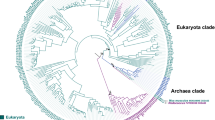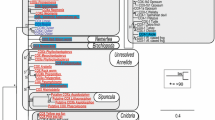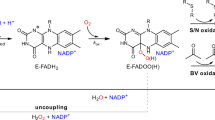Abstract
Aldehyde oxidases (AOXs) and xanthine dehydrogenases (XDHs) belong to the family of molybdo-flavoenzymes. Although AOXs are not identifiable in fungi, these enzymes are represented in certain protists and the majority of plants and vertebrates. The physiological functions and substrates of AOXs are unknown. Nevertheless, AOXs are major drug metabolizing enzymes, oxidizing a wide range of aromatic aldehydes and heterocyclic compounds of medical/toxicological importance. Using genome sequencing data, we predict the structures of AOX genes and pseudogenes, reconstructing their evolution. Fishes are the most primitive organisms with an AOX gene (AOXα), originating from the duplication of an ancestral XDH. Further evolution of fishes resulted in the duplication of AOXα into AOXβ and successive pseudogenization of AOXα. AOXβ is maintained in amphibians and it is the likely precursors of reptilian, avian, and mammalian AOX1. Amphibian AOXγ is a duplication of AOXβ and the likely ancestor of reptilian and avian AOX2, which, in turn, gave rise to mammalian AOX3L1. Subsequent gene duplications generated the two mammalian genes, AOX3 and AOX4. The evolution of mammalian AOX genes is dominated by pseudogenization and deletion events. Our analysis is relevant from a structural point of view, as it provides information on the residues characterizing the three domains of each mammalian AOX isoenzyme. We cloned the cDNAs encoding the AOX proteins of guinea pig and cynomolgus monkeys, two unique species as to the evolution of this enzyme family. We identify chimeric RNAs from the human AOX3 and AOX3L1 pseudogenes with potential to encode a novel microRNA.














Similar content being viewed by others
References
Garattini E, Fratelli M, Terao M (2008) Mammalian aldehyde oxidases: genetics, evolution and biochemistry. Cell Mol Life Sci 65(7–8):1019–1048
Garattini E, Fratelli M, Terao M (2009) The mammalian aldehyde oxidase gene family. Hum Genomics 4(2):119–130
Garattini E et al (2003) Mammalian molybdo-flavoenzymes, an expanding family of proteins: structure, genetics, regulation, function and pathophysiology. Biochem J 372(Pt 1):15–32
Garattini E, Terao M (2011) Increasing recognition of the importance of aldehyde oxidase in drug development and discovery. Drug Metab Rev 43(3):374–386
Coelho C et al (2012) The first mammalian aldehyde oxidase crystal structure: insights into substrate specificity. J Biol Chem 287(48):40690–40702
Enroth C et al (2000) Crystal structures of bovine milk xanthine dehydrogenase and xanthine oxidase: structure-based mechanism of conversion. Proc Natl Acad Sci USA 97(20):10723–10728
Garattini E, Terao M (2012) The role of aldehyde oxidase in drug metabolism. Expert Opin Drug Metab Toxicol 8(4):487–503
Sekimoto H et al (1997) Cloning and molecular characterization of plant aldehyde oxidase. J Biol Chem 272(24):15280–15285
Seo M et al (2004) Comparative studies on the Arabidopsis aldehyde oxidase (AAO) gene family revealed a major role of AAO3 in ABA biosynthesis in seeds. Plant Cell Physiol 45(11):1694–1703
Seo M et al (2000) The Arabidopsis aldehyde oxidase 3 (AAO3) gene product catalyzes the final step in abscisic acid biosynthesis in leaves. Proc Natl Acad Sci USA 97(23):12908–12913
Yang L et al (2009) Cloning and expression analysis of an aldehyde oxidase gene in Arachis hygogaea L. J Environ Biol 30(1):93–98
Taylor NJ, Cowan AK (2004) Xanthine dehydrogenase and aldehyde oxidase impact plant hormone homeostasis and affect fruit size in ‘Hass’ avocado. J Plant Res 117(2):121–130
Yesbergenova Z et al (2005) The plant Mo-hydroxylases aldehyde oxidase and xanthine dehydrogenase have distinct reactive oxygen species signatures and are induced by drought and abscisic acid. Plant J 42(6):862–876
Hartmann T et al (2012) The impact of single nucleotide polymorphisms on human aldehyde oxidase. Drug Metab Dispos 40(5):856–864
Pryde DC et al (2010) Aldehyde oxidase: an enzyme of emerging importance in drug discovery. J Med Chem 53(24):8441–8460
Cazzaniga G et al (1994) Chromosomal mapping, isolation, and characterization of the mouse xanthine dehydrogenase gene. Genomics 23(2):390–402
Kurosaki M et al (1999) Molecular cloning of the cDNA coding for mouse aldehyde oxidase: tissue distribution and regulation in vivo by testosterone. Biochem J 341(Pt 1):71–80
Kurosaki M et al (2004) The aldehyde oxidase gene cluster in mice and rats. Aldehyde oxidase homologue 3, a novel member of the molybdo-flavoenzyme family with selective expression in the olfactory mucosa. J Biol Chem 279(48):50482–50498
Terao M et al (2001) Purification of the aldehyde oxidase homolog 1 (AOH1) protein and cloning of the AOH1 and aldehyde oxidase homolog 2 (AOH2) genes. Identification of a novel molybdo-flavoprotein gene cluster on mouse chromosome 1. J Biol Chem 276(49):46347–46363
Terao M et al (2000) Cloning of the cDNAs coding for two novel molybdo-flavoproteins showing high similarity with aldehyde oxidase and xanthine oxidoreductase. J Biol Chem 275(39):30690–30700
Obach RS et al (2004) Human liver aldehyde oxidase: inhibition by 239 drugs. J Clin Pharmacol 44(1):7–19
Terao M et al (2009) Role of the molybdoflavoenzyme aldehyde oxidase homolog 2 in the biosynthesis of retinoic acid: generation and characterization of a knockout mouse. Mol Cell Biol 29(2):357–377
Rodriguez-Trelles F, Tarrio R, Ayala FJ (2003) Convergent neofunctionalization by positive Darwinian selection after ancient recurrent duplications of the xanthine dehydrogenase gene. Proc Natl Acad Sci USA 100(23):13413–13417
Terao M et al (2006) Avian and canine aldehyde oxidases. Novel insights into the biology and evolution of molybdo-flavoenzymes. J Biol Chem 281(28):19748–19761
Guindon S, Gascuel O (2003) A simple, fast, and accurate algorithm to estimate large phylogenies by maximum likelihood. Syst Biol 52(5):696–704
Gascuel O (1997) BIONJ: an improved version of the NJ algorithm based on a simple model of sequence data. Mol Biol Evol 14(7):685–695
St John JA et al (2012) Sequencing three crocodilian genomes to illuminate the evolution of archosaurs and amniotes. Genome Biol. 13(1):415
Tyagi S et al (2008) CID-miRNA: a web server for prediction of novel miRNA precursors in human genome. Biochem Biophys Res Commun 372(4):831–834
Gess RW, Coates MI, Rubidge BS (2006) A lamprey from the Devonian period of South Africa. Nature 443(7114):981–984
San Mauro D (2010) A multilocus timescale for the origin of extant amphibians. Mol Phylogenet Evol 56(2):554–561
Bininda-Emonds OR et al (2007) The delayed rise of present-day mammals. Nature 446(7135):507–512
Price SA et al (2012) Tempo of trophic evolution and its impact on mammalian diversification. Proc Natl Acad Sci USA 109(18):7008–7012
Davies TJ et al (2008) Colloquium paper: phylogenetic trees and the future of mammalian biodiversity. Proc Natl Acad Sci USA 105(Suppl 1):11556–11563
Fritz SA, Bininda-Emonds OR, Purvis A (2009) Geographical variation in predictors of mammalian extinction risk: big is bad, but only in the tropics. Ecol Lett 12(6):538–549
Barrow EC, Seiffert ER, Simons EL (2010) A primitive hyracoid (Mammalia, Paenungulata) from the early Priabonian (Late Eocene) of Egypt. J Syst Palaeontol 8(2):213–244
Pumo DE et al (1998) Complete mitochondrial genome of a neotropical fruit bat, Artibeus jamaicensis, and a new hypothesis of the relationships of bats to other eutherian mammals. J Mol Evol 47(6):709–717
Gingerich PD et al (2001) Origin of whales from early artiodactyls: hands and feet of Eocene Protocetidae from Pakistan. Science 293(5538):2239–2242
Nyakatura K, Bininda-Emonds OR (2012) Updating the evolutionary history of Carnivora (Mammalia): a new species-level supertree complete with divergence time estimates. BMC Biol 10:12
Springer MS et al (2003) Placental mammal diversification and the Cretaceous-Tertiary boundary. Proc Natl Acad Sci USA 100(3):1056–1061
Eizirik E et al (2010) Pattern and timing of diversification of the mammalian order Carnivora inferred from multiple nuclear gene sequences. Mol Phylogenet Evol 56(1):49–63
Groves C (1998) Primate evolution—in and out of Africa. Curr Biol 8(21):R747 (author reply 747–748)
Schrago CG, Russo CA (2003) Timing the origin of New World monkeys. Mol Biol Evol 20(10):1620–1625
Wildman DE et al (2009) A fully resolved genus level phylogeny of neotropical primates (Platyrrhini). Mol Phylogenet Evol 53(3):694–702
Chono H et al (2011) In vivo safety and persistence of endoribonuclease gene-transduced CD4+ T cells in cynomolgus macaques for HIV-1 gene therapy model. PLoS One 6(8):e23585
Van Rompay KK (2012) The use of nonhuman primate models of HIV infection for the evaluation of antiviral strategies. AIDS Res Hum Retroviruses 28(1):16–35
Smalheiser NR (2003) EST analyses predict the existence of a population of chimeric microRNA precursor-mRNA transcripts expressed in normal human and mouse tissues. Genome Biol 4(7):403
Devor EJ (2006) Primate microRNAs miR-220 and miR-492 lie within processed pseudogenes. J Hered 97(2):186–190
Guo X et al (2009) Small RNAs originated from pseudogenes: cis- or trans-acting? PLoS Comput Biol 5(7):e1000449
Ambros V (2004) The functions of animal microRNAs. Nature 431(7006):350–355
Eger BT et al (2000) Purification, crystallization and preliminary X-ray diffraction studies of xanthine dehydrogenase and xanthine oxidase isolated from bovine milk. Acta Crystallogr D Biol Crystallogr 56(Pt 12):1656–1658
Kuwabara Y et al (2003) Unique amino acids cluster for switching from the dehydrogenase to oxidase form of xanthine oxidoreductase. Proc Natl Acad Sci USA 100(14):8170–8175
Nishino T, Okamoto K (2000) The role of the [2Fe–2s] cluster centers in xanthine oxidoreductase. J Inorg Biochem 82(1–4):43–49
Rehorek SJ, Firth BT, Hutchinson MN (2000) The structure of the nasal chemosensory system in squamate reptiles. 2. Lubricatory capacity of the vomeronasal organ. J Biosci 25(2):181–190
Rehorek SJ, Firth BT, Hutchinson MN (2000) The structure of the nasal chemosensory system in squamate reptiles. 1. The olfactory organ, with special reference to olfaction in geckos. J Biosci 25(2):173–179
Acknowledgments
Grants from the Telethon-Italy Foundation, the Fondazione Cariplo, the Fondazione Italo Monzino, and the Negri-Weizmann Foundation were fundamental for the completion of this work. The work was also partially supported with grants from the Associazione Italiana per la Ricerca contro il Cancro (AIRC). We would like to thank the talented student, Valentina Novelli for sequence analysis. We acknowledge the help of Felice Deceglie with the artwork.
Author information
Authors and Affiliations
Corresponding author
Additional information
M. Kurosaki and M. Bolis contributed equally to this work.
Electronic supplementary material
Below is the link to the electronic supplementary material.
Rights and permissions
About this article
Cite this article
Kurosaki, M., Bolis, M., Fratelli, M. et al. Structure and evolution of vertebrate aldehyde oxidases: from gene duplication to gene suppression. Cell. Mol. Life Sci. 70, 1807–1830 (2013). https://doi.org/10.1007/s00018-012-1229-5
Received:
Revised:
Accepted:
Published:
Issue Date:
DOI: https://doi.org/10.1007/s00018-012-1229-5




